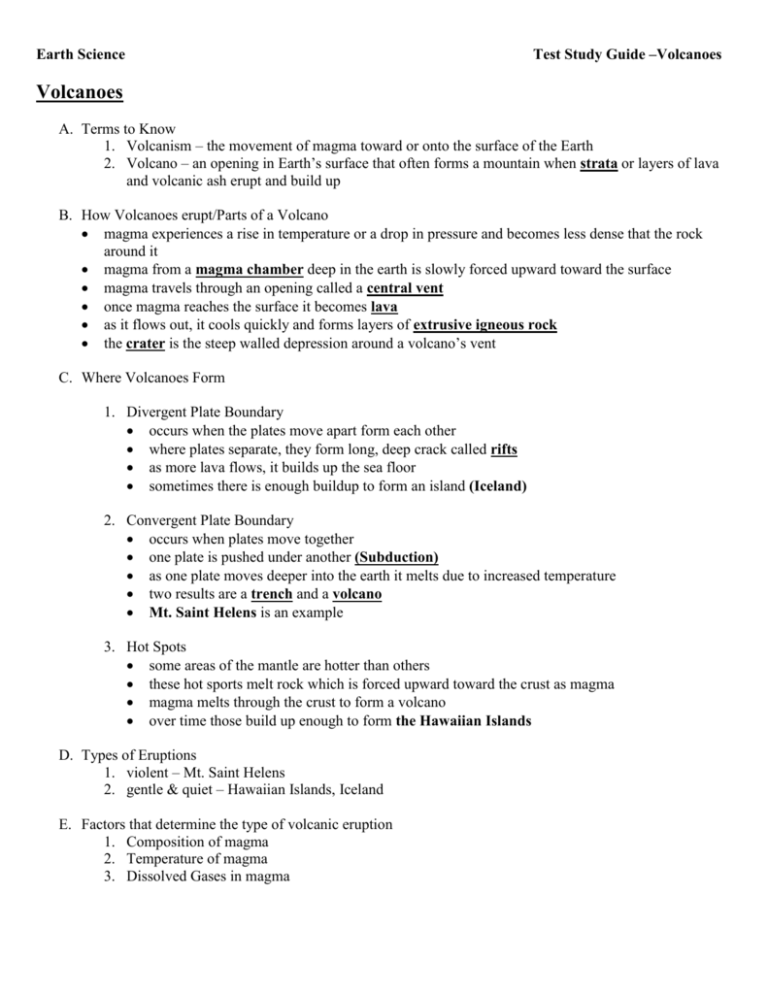Volcanoes - study guide
advertisement

Earth Science Test Study Guide –Volcanoes Volcanoes A. Terms to Know 1. Volcanism – the movement of magma toward or onto the surface of the Earth 2. Volcano – an opening in Earth’s surface that often forms a mountain when strata or layers of lava and volcanic ash erupt and build up B. How Volcanoes erupt/Parts of a Volcano magma experiences a rise in temperature or a drop in pressure and becomes less dense that the rock around it magma from a magma chamber deep in the earth is slowly forced upward toward the surface magma travels through an opening called a central vent once magma reaches the surface it becomes lava as it flows out, it cools quickly and forms layers of extrusive igneous rock the crater is the steep walled depression around a volcano’s vent C. Where Volcanoes Form 1. Divergent Plate Boundary occurs when the plates move apart form each other where plates separate, they form long, deep crack called rifts as more lava flows, it builds up the sea floor sometimes there is enough buildup to form an island (Iceland) 2. Convergent Plate Boundary occurs when plates move together one plate is pushed under another (Subduction) as one plate moves deeper into the earth it melts due to increased temperature two results are a trench and a volcano Mt. Saint Helens is an example 3. Hot Spots some areas of the mantle are hotter than others these hot sports melt rock which is forced upward toward the crust as magma magma melts through the crust to form a volcano over time those build up enough to form the Hawaiian Islands D. Types of Eruptions 1. violent – Mt. Saint Helens 2. gentle & quiet – Hawaiian Islands, Iceland E. Factors that determine the type of volcanic eruption 1. Composition of magma 2. Temperature of magma 3. Dissolved Gases in magma Tendency to form Pyroclastics Composition Silica Content Viscosity (fluidity) Gas Content Balsitic Magma Least (- 50%) Least Least (1 – 2%) Least Andesitic Magma Intermediate (- 60%) Intermediate Intermediate (3 – 4%) Intermediate Rhyolitic Magma Most (- 70%) Greatest Greatest (4 – 6%) Greatest Volcanic Landform Shield Volcanoes Some Cinder Cones Cinder Cones Some Composite Cones Composite Cones Some Volcanic domes F. Types of Volcanoes 1. Shield Volcano – broad volcano with gently sloping sides (Hawaiian Islands) 2. Cinder Cone – steepest-sided, loosely packed volcano formed from tephra (Sunset Crater) 3. Composite Cone – volcano with fairly steep sides, formed from alternating layers of tephra and lava (Mt. St. Helens, Mount Rainier) G. What Comes Out of a Volcano 1. Tephra – 4 types Ash – fine/small in size Lapilli – small to medium in size volcanic bombs – medium to coarse in size volcanic blocks – coarse to large in size 2. Lava – 3 types Basaltic flow – fluid lava flow Pahoehoe flow – lava flow that wrinkles Aa flow – lava flow with rough edges H. Additional Terms to Know 1. dike – magma hardened in a vertical crack (Pluton) 2. sill – magma hardened in a horizontal crack (Pluton) 3. laccoliths – lens shaped structure composed of viscous magma (Pluton) 4. batholiths – largest pluton, mountain that forms form layers of lava and ash (Pluton) 5. stock – formed the same way as a batholith but it is much smaller in size (Pluton) 6. volcanic neck – solid magma core exposed when volcano cone erodes away (Pluton) 7. caldera – a volcano that has had its top collapse forming a large depression that often fills with water (ex. Crater Lake, Mount Kilauea) 8. lahar – a mudflow as a result of a volcano Be able to identify pictures of plutonic features.








